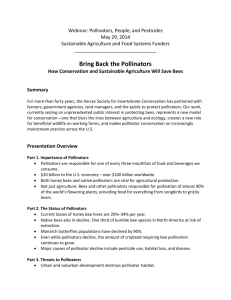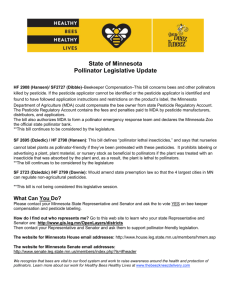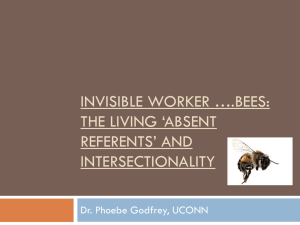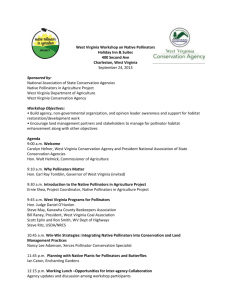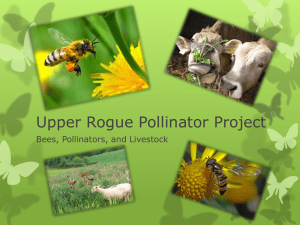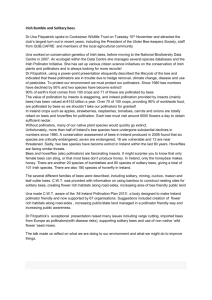Teaching Notes
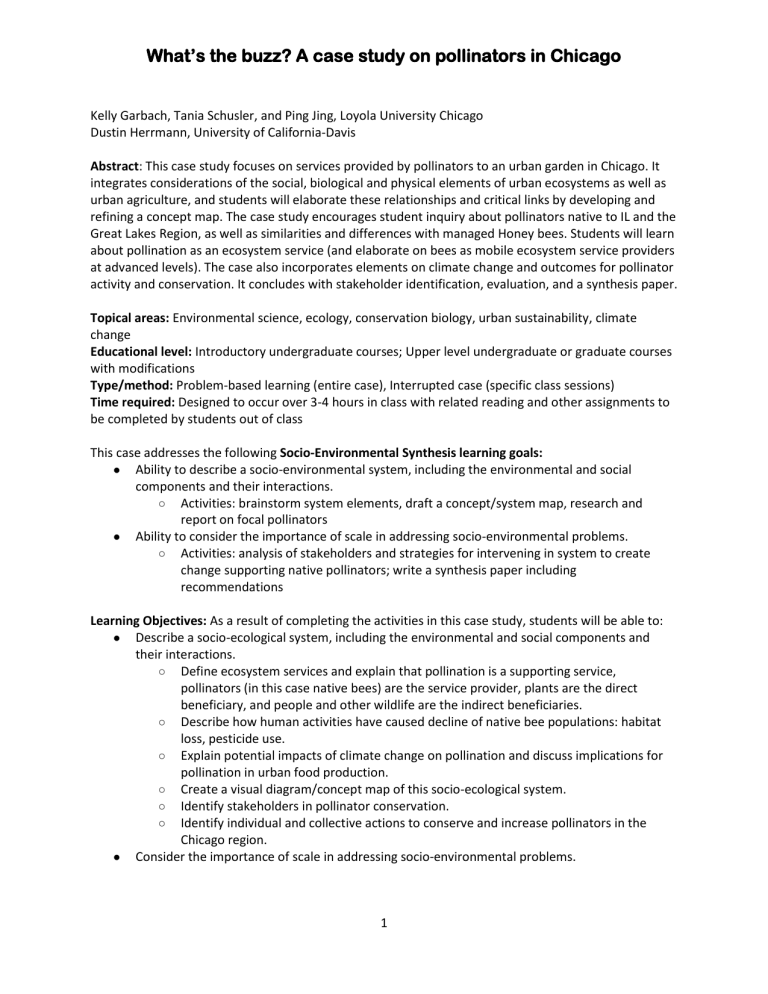
What’s the buzz? A case study on pollinators in Chicago
Kelly Garbach, Tania Schusler, and Ping Jing, Loyola University Chicago
Dustin Herrmann, University of California-Davis
Abstract: This case study focuses on services provided by pollinators to an urban garden in Chicago. It integrates considerations of the social, biological and physical elements of urban ecosystems as well as urban agriculture, and students will elaborate these relationships and critical links by developing and refining a concept map. The case study encourages student inquiry about pollinators native to IL and the
Great Lakes Region, as well as similarities and differences with managed Honey bees. Students will learn about pollination as an ecosystem service (and elaborate on bees as mobile ecosystem service providers at advanced levels). The case also incorporates elements on climate change and outcomes for pollinator activity and conservation. It concludes with stakeholder identification, evaluation, and a synthesis paper.
Topical areas: Environmental science, ecology, conservation biology, urban sustainability, climate change
Educational level: Introductory undergraduate courses; Upper level undergraduate or graduate courses with modifications
Type/method: Problem-based learning (entire case), Interrupted case (specific class sessions)
Time required: Designed to occur over 3-4 hours in class with related reading and other assignments to be completed by students out of class
This case addresses the following Socio-Environmental Synthesis learning goals:
● Ability to describe a socio-environmental system, including the environmental and social components and their interactions.
○ Activities: brainstorm system elements, draft a concept/system map, research and
● report on focal pollinators
Ability to consider the importance of scale in addressing socio-environmental problems.
○ Activities: analysis of stakeholders and strategies for intervening in system to create change supporting native pollinators; write a synthesis paper including recommendations
Learning Objectives: As a result of completing the activities in this case study, students will be able to:
● Describe a socio-ecological system, including the environmental and social components and their interactions.
○ Define ecosystem services and explain that pollination is a supporting service,
○ pollinators (in this case native bees) are the service provider, plants are the direct beneficiary, and people and other wildlife are the indirect beneficiaries.
Describe how human activities have caused decline of native bee populations: habitat
●
○
○
○
○ loss, pesticide use.
Explain potential impacts of climate change on pollination and discuss implications for pollination in urban food production.
Create a visual diagram/concept map of this socio-ecological system.
Identify stakeholders in pollinator conservation.
Identify individual and collective actions to conserve and increase pollinators in the
Chicago region.
Consider the importance of scale in addressing socio-environmental problems.
1
What’s the buzz? A case study on pollinators in Chicago
○ Describe interactions between people and pollinators across geographic and temporal scales, and explain nestedness (i.e., a backyard nested in a neighborhood nested in the city nested in the region)
Introduction/Background: This case was developed for a 100-level environmental science course for predominantly non-majors. It is suitable for introductory courses in environmental studies, ecology, conservation biology, or urban sustainability and could be modified for upper level courses. The case begins with the story of an urban garden manager who is puzzled by a poor squash harvest. This leads to discussions on the importance of pollinators for ecosystems and human society.
Classroom Management: The case is designed to occur over three class periods, which we refer to as
“blocks.” Classroom management notes are provided below for each of the three blocks.
BLOCK ONE
The following class management notes accompany the Power Point, in-class activities, and bee research assignment in Block One (B1). Prior to class, students should read the Preface and Chapter 1 from
Attracting Native Pollinators by The Xerces Society.
● Present the focal garden, Uncommon Ground. Encourage the class to discuss challenges/opportunities they perceive for growers in an urban environment.
● Talk through Guiding Question 1: What are the biotic and abiotic resources needed for producing food in an urban environment? Do these have management considerations that are similar/different from considerations in rural farms?
Notes: students should think about the following abiotic factors at a minimum:
Soil, light, water, temperature
Soil and water considerations: soil may need to be collected and transported from another location (especially if we’re talking about created garden beds on a hard surface, such as the rooftop garden in our focal garden). Advanced students may also note that soil formation and nutrient cycling processes are not likely to occur naturally, and must be “engineered” by the managers of the agroecosystem. Water also needs to brought in: main choices are municipal water (e.g., standard hose & sprinklers) and rainwater capture. Rainwater can be a good option, but filtering is often needed and if stored for longer periods of time, limiting growth of bacteria/ potential pathogens is a key consideration.
Light and temperature considerations: light intensity and availability will vary seasonally; shade from other buildings is often an important consideration in the city for garden placement (e.g., plants in beds placed in full shade may not thrive). Sun-loving plants like tomatoes, should be placed in beds that get the most light; plants that are tolerant of cooler temps and some shade can be placed elsewhere.
Biotic factors to consider:
Humans, plants we select, all the fauna associated with plants: including beneficial insects, like bees that provide pollination, as well as organisms that can act as pests, including herbivores that graze on plants as well as the web of their natural enemies (e.g., parasites and predators).
Humans (and our pets!) can also play the role of pests in an urban environment, if we harvest crops uninvited, or contaminate growing areas with trash or other wastes.
2
What’s the buzz? A case study on pollinators in Chicago
Activity1: Students sit in groups of 2-3 to discuss Guiding Questions, and write down notes on the Guiding Questions. Remind students to write legibly, as these responses will be turned in at the end of the class meeting.
The instructor may also consider filling in the slide as students brainstorm (with an intro-level class). These responses will create a bank of ideas to draw upon in the concept map in Activity 2.
● Talk through Guiding Question 2: Pollinators were among the important biotic factors in our agroecosystem. How do growers determine the importance of pollination on their garden or farm? Hint: What crops are being grown? Which depend on pollinators?
Notes: This may be a good time to review some highlights of the pollination chapter from Xerces
Society (which students read prior to class)—Key highlights include that about 70% of our staple crops require insect pollination, and that 1 in every 3 mouthfuls of food and drink is pollinated by bees. Students should have captured that honey bees are an important part of this equation, and that European honey bees are an introduced species that’s placed in hives and managed near crops. There are also a number of bee species that are native to IL (this will be further developed in the Bee Research and Reporting Assignment).
● Talk through developing a concept map—
Describe the key elements of the social, biological and physical elements in our case study on
Chicago pollinators. Create a visual representation on how they fit together, and their key interactions.
Notes: We’ve discussed important elements of the social, biological and physical elements in our case study on pollinators in Chicago. Your task is draw out how these elements fit together, as well as key interactions. Make sure your drawing is clear and well-labeled, and includes your name so that you can turn in your concept map at the end of class.
This poster on the slide was created by the pollinator partnership, (Pollinator Partnership: www.pollinator.org
) and it has some elements of how social, and biological elements relate to one another (Note: there’s not much going on here for the physical environment). Instructor may want to emphasize that this approach needs more detail to be an appropriate concept map for a class output.
● This second concept map describes major categories discussed in relation to resource governance in social-ecological systems, found on www.sciencedirect.com
. Highlight that students may want to consider including the social, ecological and physical systems as the major categories in their concept maps. Then these categories will need an additional level of detail, that describes the key elements included in each. As the concept map progresses, students should be thinking about how the key elements interact. This can be represented visually with arrows—and students should be able to describe what each of the arrows represents. This is something that students have seen before with food webs.
● Activity 2: Have students work in groups of 3 to draw concept maps (a sheet is included in page
3 of the student handout). This should take about 15-20mins. Encourage students to discuss with one another, and raise questions to share with the broader group. Remind students that this draft will be turned in at the end of class, and the whole team (class) will revisit their drafts in Blocks 2, 3 of this case study.
3
What’s the buzz? A case study on pollinators in Chicago
● Transition to talking about bee research and reporting assignment. Introduce the focal bee species with visuals, and then distribute and talk through assignment:
As an early career environmental scientist, you’ve been tasked with researching bees in the Chicago area as part of a case study on urban agriculture and pollinator conservation. There are excellent resources at your disposal through the following partner organizations:
● Xerces Society’s Pollinator resource center: http://www.xerces.org/pollinator-resource-center/
● Chicago Botanic Garden: http://www.chicagobotanic.org/conservation/bees
● University of Illinois Chicago: http://atlas.las.uic.edu/atlas/2011/12/studying-bee-pollinators-toaid-urban-agriculture
● Bee Spotter: http://beespotter.mste.illinois.edu/
In addition to exploring around and using these resources, highlight that these links are starting points; it’s very important to follow up with other pages and explore beyond the suggested “landing page.”
Note that students need to identify and suggest at least two additional/original resources as they research and report on the five focal bee species. Resources can be books, articles, or online resources.
Instructors may wish to specify a citation style for students to use.
Conclude Block One (B1) with the following next steps:
Turn in at the end of class:
● Turn in your notes on the guiding questions (handout)
● Draft Concept map
For next time:
● Research on pollinators completed and ready to turn in at the start of class. This includes details for each focal pollinator, as well as recommendations for at least two
additional/original resources.
BLOCK TWO
In Block Two (B2), students are asked to discuss in groups the impact of climate change on pollinators, such as bees. Using their understanding of the important ecosystem services provided by pollinators, students also discuss the consequent impacts on farmers. A PowerPoint document accompanies this
Block.
1. Introduction (5 minutes)
Describe to students that spring in the Rocky Mountains now arrives earlier, as indicated by earlier snowmelt in the Rockies. Ask the students the guiding question, What may have caused the spring snowmelt to occur earlier? The instructor can use a few minutes to generally explain how human activities (such as burning fossil fuels and deforestation) have caused the enhanced greenhouse effect and therefore contributed to global climate change.
2. Have students gather into the same groups they worked in Block One. Inform the students that each group should submit one copy of their answers to the questions in the handout in writing.
4
What’s the buzz? A case study on pollinators in Chicago
3. Give students the handout, “Bee” Confused by Climate Change. Show the second PowerPoint slide of this Block.
4. Students read the story. (5 minutes)
5. Students discuss the questions in the handout. Remind them to write down their answers. (20 minutes)
BLOCK THREE
“What can we do to conserve and increase pollinators in our city?”
In Block Three (B3), students are asked to identify actions that can be taken to conserve pollinators at three scales: site, neighborhood, and region. Using their system map generated earlier, students identify opportunities for intervening in the system to create changes intended to conserve or increase pollinators in the city. As they move from the site to larger geographic scales, they (1) recognize the nestedness of systems, and (2) realize the need to work with other stakeholders in order to have impact beyond the site scale. Students then learn how to conduct a stakeholder analysis, identify strategies for involving other stakeholders, and assess the likely effectiveness of proposed actions at these three geographic scales in the short- and long-term (bringing in the concept of temporal scale). Block 3 concludes with an out-of-class assignment for students to produce a written proposal explaining their assessment of the opportunities to intervene in the system and recommendations for actions to conserve and increase pollinators.
The block consists of 2 parts:
3.1 - Site Scale: Uncommon Ground (30 minutes)
1.
Have students gather into the same groups they worked in for the prior blocks.
2.
Inform students that they will need to use today’s work in class for the individual paper assignment; thus, each student should take notes for reference outside of class.
3.
Ask students to read the next portion of Jen’s story and follow instructions in the student handout. (15 minutes) a.
Instructions to students: b.
Using the research you did outside of class on native pollinators, develop a list of recommendations for Jen based on your knowledge of what crops each bee pollinates, its habitat preferences, and foraging distances. Each group will turn in one copy of its recommendations at the end of class. Be sure to include the following: i.
Target pollinator (i.e., which bee?) ii.
Actions Jen can take to conserve or increase this pollinator’s presence in the garden iii.
Rationale for why these actions makes sense based on what you know about this pollinator c.
As a group discuss: i.
Will these actions be sufficient to reach Jen’s goal of increasing pollinators in the garden? Why or why not? Reference your system map to answer these questions.
5
What’s the buzz? A case study on pollinators in Chicago
4.
Ask students to report out from discussion of final question. Have all groups report at once by writing their answer - Yes or No - on a piece of paper and showing it for all to see. Then discuss as a full class why students responded as they did. Students might explain, for example, that Jen manages only a small area of garden space and could have greater impact on pollinator populations through management over a larger area of land. Or they might suggest that Jen can grow as many plants as possible to attract pollinators, but if others in her neighborhood are using pesticides (e.g., on lawns, golf courses) that harm bees, then her efforts might not succeed. Emphasize the concepts of systems, nestedness, and scale. (5 minutes)
5.
Introduce concept of “stakeholder” and procedure for “stakeholder analysis” using the lecture slides and speaking notes provided (“BeeCase_B3_ClassPowerPoint_Stakeholder
Analysis.pptx”). (10 minutes)
3.2 - Larger Scales: Rogers Park Neighborhood and Chicago Region (45 minutes)
1.
In their groups, students conduct a stakeholder analysis. Designate half of the groups to focus on the neighborhood scale (Rogers Park) and the other half to focus on the regional scale. Hand out a Stakeholder Analysis Worksheet to each student, which he or she should take notes on for later reference. Each group should also reproduce the chart on chalkboard, white board, or newsprint large enough for full class to see and record their work there. (5 minutes)
2.
Students articulate the goal(s), identify stakeholders, estimate attitudes and influence, determine level of confidence in these estimates, and develop strategies for involving priority stakeholders. Encourage students to reference their system maps in identifying stakeholders and strategies/actions. (15 minutes)
3.
Post all group’s completed work simultaneously and allow ~2 minutes for students to review all charts. Then discuss as a full class. Encourage students to add details on their individual worksheets based on other group’s charts and this discussion. Multiple groups likely will have identified some similar stakeholders and strategies. Begin discussion with the far left column,
Stakeholders, and focus on differences between groups. For example, if one student group identified community gardeners (or local schools or the Alderperson) as a stakeholder in the neighborhood and other groups did not, ask whether other groups overlooked this stakeholder or did not think that it constitutes a stakeholder in pollinator conservation. Then move the discussion’s focus to the far right column, Strategies, and ask a group to explain why they proposed a specific strategy. In providing their logic or rationale, students should reference their columns estimating Attitude and Influence. Examples of strategies include coordinated management (e.g., multiple community gardens growing plants to attract pollinators), education
(e.g., outreach to other gardeners and land managers), planning (e.g., city plans for natural areas and open space), land use (e.g., protecting and restoring native habitats), or advocating for policy changes (e.g., restrictions on pesticides). Ask if other groups agree/disagree with their assessment, why or why not, etc. Finally, ask students for their opinions regarding the likely impact of different strategies. Which are most likely to succeed in the short-term? Over the long-term? Why? Emphasize that different strategies are needed over different temporal scales.
(15 minutes)
4.
Wrap up the discussion by reiterating key ideas: concept of scale, nestedness of systems, definition of stakeholder, process of stakeholder analysis (5 minutes)
6
What’s the buzz? A case study on pollinators in Chicago
5.
Provide instructions (“BeeCase_B3_Student Paper Assignment.docx”) for assignment to write a proposal with recommendations for Jen. This assignment is to be completed by each individual student outside of class and due in 1 week. (5 minutes)
References:
The Xerces Society for Invertebrate Conservation http://www.xerces.org/
International Pollinator’s Initiative, Food and Agriculture Organization, United Nations http://www.internationalpollinatorsinitiative.org/
BeeSpotter, University of Illinois (citizen science project) http://beespotter.mste.illinois.edu/
The Great Sunflower Project (citizen science project) http://www.greatsunflower.org/
U.S. Climate Change Research Program (2009), Climate Change in the Midwest, http://nca2009.globalchange.gov/midwest
Dick, B. 1997. Stakeholder Analysis [Online]. Available at http://www.uq.net.au/action_research/arp/stake.html
.
Forrest and Thomson (2011), An examination of synchrony between insect emergence and flowering in
Rocky Mountain meadows, Ecological Monographs, 81(3), 2011, pp. 469–491.
McKinney and Inouye (2012), Phenology of species interactions in response to climate change: two case studies of plant-pollinator interactions using long-term data, 2012 Fall Meeting, AGU, San Francisco,
CA, 3-7 Dec.
Spivak, M., Mader, E., Vaughan, M., and Euliss, Jr., N. H. 2011. The plight of the bees. Environmental
Science and Technology 45:34-38.
Steltzer et al. (2012), When Snow Melts Early: The Unusual Alpine Plant Life Histories During the
Summer of 2012, 2012 Fall Meeting AGU, San Francisco, CA 3-7 Dec.
Xerces Society (2011), Attracting Native Pollinators: Protecting America’s Bees and Butterflies. North
Adams, MA: Storey Publishing.
Answer Key: Answer keys are provided below for specific blocks.
BLOCK ONE
Teacher’s Notes for Interpreting the Example “Mature” Concept/System Map
The concept map provided is designed to give the instructor a full view of the interacting systems.
Students will develop their own concept maps that may not have all the systems as represented here. In addition, students will likely specify components and interactions that are not present in this example.
Use the provided concept map as a way to guide discussions and to evaluate the completeness of students’ final concept map. Below the components and their interactions are broadly discussed.
7
What’s the buzz? A case study on pollinators in Chicago
Ecosystem Services and Human Well-being - (see also recommended reading - Daily 1997
Introduction: What are Ecosystem Services?) Two ecosystem services are explicitly represented in the system map: Pollination and Food production. Pollination is a Supporting Service. Food production is a Provisioning Service. An important class exercise is to identify the services in the system and have the students be sure to include them in their own conceptual maps.
Importantly, ecosystem services must contribute to Human well-being. In this case the economic, food, community and personal outcomes that come arise from urban agriculture and pollination existing may be considered the ecosystem services’ benefits to human well-being.
Jen, the urban farmer and restaurant manager - Although, not actually put on the provided conceptual map, Jen - our protagonist - lies at the center of our system because her issue and her perspective on it are central to the systems and their interactions. She is most intimately linked with Urban agriculture but more specifically growing food in the city for keeping her local food restaurant successful.
Physical System - The physical system is the urban environment and the activities in it. The abiotic components discussed in Block 1 – light, water, soil, etc. - would be part of the physical system. Climate change and the urban environment are included here as well. Warmer
8
What’s the buzz? A case study on pollinators in Chicago temperatures are a characteristic of both. Climate change is discussed in Block 2. The urban climate is often hotter than rural areas mainly because buildings and paved surfaces absorb more sun energy than vegetation. Pollution may also affect bees by affecting climate and urban environmental conditions, including air, water and soil contamination and biotic interactions such as pathogen presence. Carbon dioxide is one atmospheric pollutant as a major greenhouse gas. There are also other pollutants that may affect bees, plants and pollination. Examples include particulate matter (e.g., from diesel engines), ozone, noise, and artificial light.
Linking the Physical and Biological Systems - Urban structure may also be referred to as urban habitat. Structure is the physical land cover. In an urban area this includes buildings, pavement, trees, herbaceous plants (grasses, flowering plants), soil, etc. Urban structure then serves as the bees’ habitat in the city, i.e. shelter and food in the form of floral resources. The urban environment, such as air quality, water and light, and a changing climate can also influence the quality and quantity of bee habitat.
Biological System - Shelter and floral resources maintain bee populations that pollinate flowers which is necessary for many crops and urban agriculture viability. The more floral resources and types of habitat that are in the urban landscape will lead to greater bee diversity and abundance. Larger bee populations increase pollination activity and more bee species with large populations will result in a greater number of plant species that will have the appropriate pollinator at the right time of right. There is also a positive feedback where more pollination improves plant success and can then support greater bee diversity and abundance.
Linking the Biological and Social Systems - Urban agriculture relies on bees pollinating a broad suite of crops throughout the growing season. Urban agriculture is an activity that is important to human well-being by supplying nutritious food and supporting social system functions related to economics, public health and community networks.
Social System - The most obvious product of urban agriculture is nutritious food. This can be an important component of improving the health of individuals, especially where access to nutritious foods is limited by local availability or personal economic factors. Urban agriculture can also boost the local economy; an example of this is the financial success of Uncommon
Ground. Moreover, community groups form and social networks may improve. Students will likely need to specify these interactions with regards to stakeholders and the connections among stakeholders. Both food and the more dispersed benefits of urban agriculture can positively affect human well-being. Benefits to human well-being, importantly, are the necessary outcome for an ecosystem function to be a service.
Urban agriculture and activities surrounding it may changes people’s attitudes and awareness of community needs and goals. This can then shape individual level Values and Beliefs. It can also create change at higher levels of organization, i.e. affect Policy. Collectively, policy and individual behavior determine Human Activities. For example, people in the neighborhood can actively
9
What’s the buzz? A case study on pollinators in Chicago change the amount, type and quality of bee habitat and food resources in the urban setting. The city government could provide incentives for the installation of rooftop gardens.
Linking the Social and Physical Systems - Human actions connect the social system to the physical and biological systems. By increasing bee habitat, humans change urban structure. We can affect climate change and the urban climate through how we build and our control on greenhouse gas emissions. Mitigating air, water and soil pollution locally can also improve bee habitat.
BLOCK TWO
1.
How are bees affected by climate change in the Rocky Mountains? a) Earlier snowmelt in spring has led to less wildflower blossom in the Rockies, which reduces the amount of pollen available to bees. b) Climate change has caused changes in the phenology of plants. Some plants start to flower earlier, but bees arrive too late and therefore miss the flowers.
2.
Do you think bees in a city like Chicago will be affected by climate change as well? If yes, will they be affected in the same way as in the Rockies?
Yes. It’s very likely that bees in Chicago will be affected by climate change as well. Vegetation zones are migrating poleward and it is predicted that the climate of the Midwest will become more like that of the southern states. This will affect bees.
It is uncertain whether bees will be affected by climate change in the same way as in the Rockies.
Different factors should be taken into consideration. One is that snowmelt may not be a crucial source of water for plants in the Midwest; another factor is that the Midwest is not as elevated as the Rocky Mountains. Further scientific research needs to be done.
3.
How might pollinators like bees respond to climate change? [Think of three possibilities.]
(A) Migration: they migrate to a new habitat where the climate is similar to what they are used to.
(B) Adaption: they adapt to the new climate in their old habitat.
(C) Extinction: they fail to survive.
Remind students that global climate change is occurring too rapidly for species to adapt (as evolution takes time). Therefore, species (animals, plants, butterflies) have been found to migrate poleward and to higher altitudes.
4.
When plants are migrating poleward and changing the habitat of bees, can bees migrate along with them?
Bees may be able to migrate with the plants. Those who don’t will not be able to survive. But this will have a profound impact on the agriculture, people, and human society. Farmers will need to
10
What’s the buzz? A case study on pollinators in Chicago either migrate along or start to grow different crops/plants. It will cost the whole society a lot of money to make adjustments.
5.
How will farmers be affected by the declining bee population? What should they do to conserve pollinators?
Farmers who grow crops that are dependent on insect-pollination may see a reduction in their crop yield.
Farms should be encouraged to practice polyculture because monoculture usually provides floral resources for a limited period of time, which reduces the survival rate of pollinators. By practicing polycultures, farmers creates a more heterogenous agroecosystem, which has a greater resilience to climate change. In a heterogenous agroecosystem, pollinators will have a greater chance to survive because they may rely on other plants even if their main food crop fails to flower or flowers too early.
11

